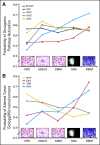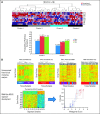Gene expression profiles of tumor biology provide a novel approach to prognosis and may guide the selection of therapeutic targets in multiple myeloma
- PMID: 19636021
- PMCID: PMC4881369
- DOI: 10.1200/JCO.2008.19.1916
Gene expression profiles of tumor biology provide a novel approach to prognosis and may guide the selection of therapeutic targets in multiple myeloma
Erratum in
- J Clin Oncol. 2012 Apr 20;30(12):1398
Abstract
Purpose: Monoclonal gammopathy of undetermined significance (MGUS) and multiple myeloma (MM) comprise heterogeneous disorders with incompletely understood molecular defects and variable clinical features. We performed gene expression profiling (GEP) with microarray data to better dissect the molecular phenotypes, sensitivity to particular chemotherapeutic agents, and prognoses of these diseases.
Methods: Using gene expression and clinical data from 877 patients ranging from normal plasma cells (NPC) to relapsed MM (RMM), we applied gene expression signatures reflecting deregulation of oncogenic pathways and tumor microenvironment to highlight molecular changes that occur as NPCs transition to MM, create a high-risk MGUS gene signature, and subgroup International Staging System (ISS) stages into more prognostically accurate clusters of patients. Lastly, we used gene signatures to predict sensitivity to conventional cytotoxic chemotherapies among identified clusters of patients.
Results: Myc upregulation and increasing chromosomal instability (CIN) characterized the evolution from NPC to RMM (P < .0001 for both). Studies of MGUS revealed that some samples shared biologic features with RMM, which comprised the basis for a high-risk MGUS signature. Regarding MM, we subclassified ISS stages into clusters based on shared features of tumor biology. These clusters differentiated themselves based on predictions for prognosis and chemotherapy sensitivity (eg, in ISS stage I, one cluster was characterized by increased CIN, cyclophosphamide resistance, and a poor prognosis).
Conclusion: GEP provides insight into the molecular defects underlying plasma cell dyscrasias that may explain their clinical heterogeneity. GEP also may also refine current prognostic and therapeutic models for MGUS and MM.
Conflict of interest statement
Authors' disclosures of potential conflicts of interest and author contributions are found at the end of this article.
Figures







Similar articles
-
Gene-expression signature of benign monoclonal gammopathy evident in multiple myeloma is linked to good prognosis.Blood. 2007 Feb 15;109(4):1692-700. doi: 10.1182/blood-2006-07-037077. Epub 2006 Oct 5. Blood. 2007. PMID: 17023574 Free PMC article.
-
99mTc-sestamibi imaging and bone marrow karyotyping in the assessment of multiple myeloma and MGUS.Nucl Med Commun. 2008 Jun;29(6):535-41. doi: 10.1097/MNM.0b013e3282f5e5df. Nucl Med Commun. 2008. PMID: 18458600
-
Gene expression signatures, clinicopathological features, and individualized therapy in breast cancer.JAMA. 2008 Apr 2;299(13):1574-87. doi: 10.1001/jama.299.13.1574. JAMA. 2008. Retraction in: JAMA. 2012 Feb 1;307(5):453. doi: 10.1001/jama.2012.2. PMID: 18387932 Retracted.
-
New insights in the clinical biology of multiple myeloma.Semin Hematol. 1997 Jan;34(1 Suppl 1):23-8. Semin Hematol. 1997. PMID: 9122743 Review.
-
Future Directions in the Evaluation and Treatment of Precursor Plasma Cell Disorders.Am Soc Clin Oncol Educ Book. 2016;35:e400-6. doi: 10.1200/EDBK_159010. Am Soc Clin Oncol Educ Book. 2016. PMID: 27249747 Review.
Cited by
-
Progress in myeloma stem cells.Am J Blood Res. 2011;1(2):135-45. Epub 2011 Sep 8. Am J Blood Res. 2011. PMID: 22432075 Free PMC article.
-
Mast cells and Th17 cells contribute to the lymphoma-associated pro-inflammatory microenvironment of angioimmunoblastic T-cell lymphoma.Am J Pathol. 2010 Aug;177(2):792-802. doi: 10.2353/ajpath.2010.091286. Epub 2010 Jul 1. Am J Pathol. 2010. PMID: 20595635 Free PMC article.
-
Critical Role for Cap-Independent c-MYC Translation in Progression of Multiple Myeloma.Mol Cancer Ther. 2022 Apr 1;21(4):502-510. doi: 10.1158/1535-7163.MCT-21-0016. Mol Cancer Ther. 2022. PMID: 35086951 Free PMC article.
-
Destabilizing NEK2 overcomes resistance to proteasome inhibition in multiple myeloma.J Clin Invest. 2018 Jul 2;128(7):2877-2893. doi: 10.1172/JCI98765. Epub 2018 Jun 4. J Clin Invest. 2018. PMID: 29863498 Free PMC article.
-
Caloric restriction augments radiation efficacy in breast cancer.Cell Cycle. 2013 Jun 15;12(12):1955-63. doi: 10.4161/cc.25016. Epub 2013 May 21. Cell Cycle. 2013. PMID: 23708519 Free PMC article.
References
-
- Kyle RA, Therneau TM, Rajkumar SV, et al. A long-term study of prognosis in monoclonal gammopathy of undetermined significance. N Engl J Med. 2002;346:564–569. - PubMed
-
- Rajkumar SV. MGUS and smoldering multiple myeloma: Update on pathogenesis, natural history, and management. Hematology Am Soc Hematol Educ Program. 2005:340–345. - PubMed
-
- Kyle RA, Rajkumar SV. Monoclonal gammopathy of undetermined significance. Br J Haematol. 2006;134:573–589. - PubMed
-
- Bergsagel PL, Kuehl WM. Chromosome translocations in multiple myeloma. Oncogene. 2001;20:5611–5622. - PubMed
-
- Fonseca R, Bailey RJ, Ahmann GJ, et al. Genomic abnormalities in monoclonal gammopathy of undetermined significance. Blood. 2002;100:1417–1424. - PubMed
MeSH terms
Substances
Grants and funding
LinkOut - more resources
Full Text Sources
Medical

